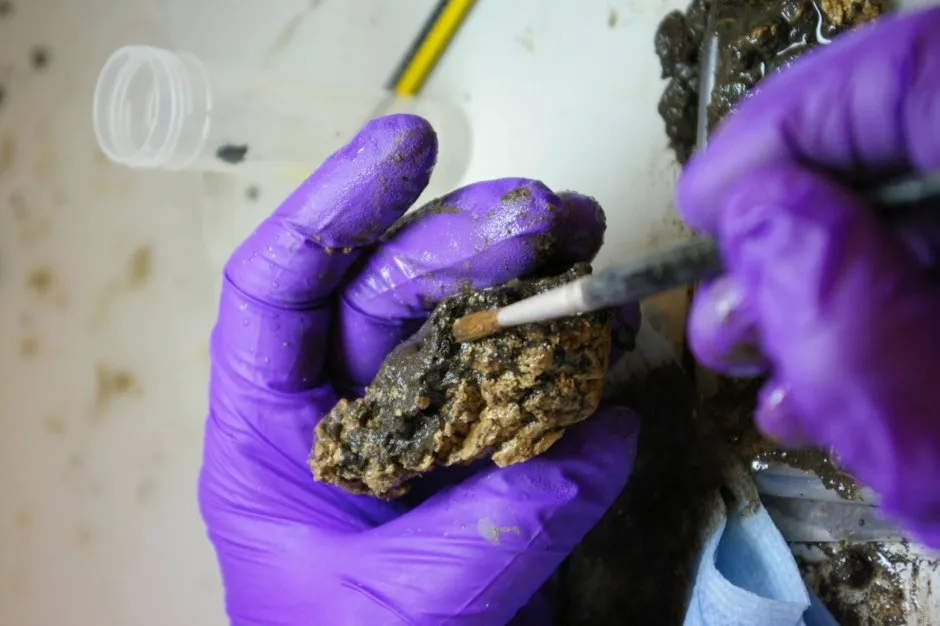Scientists have unlocked some of the secrets behind the preservation of a 2,600-year-old human brain that was discovered in York.
The Iron Age brain was spotted inside a skull found in a muddy pit during excavations in the Heslington area in 2008.
It is believed to be one of the oldest to be found in the UK (673-482 BC).
When it was discovered, scientists were immediately intrigued by how the delicate tissue had been preserved.
The brain matter was the only soft tissue that remained in the skull.
Read more about ancient human remains:
- Babies from ancient Ecuador found wearing the skulls of other children as helmets
- Evidence of brutal 33,000-year-old murder found on fossilised skull
- Solving the Piltdown Man crime: how we worked out there was only one forger
In a new study published in the Journal of the Royal Society Interface, researchers spent a year unpacking the densely folded proteins that had created such a stable state for the brain tissue, and found it regained many of the features found in normal, living brain tissue.
The researchers from University College London (UCL) show that of those substances which hold a human brain together, notably proteins, can fold themselves tightly into very stable structures, called aggregates.
Once unfolded – a process which took one year – these proteins regain many of the features typically encountered in a normal, living human brain.
Scientists say the findings have implications for palaeoproteomics, biomarker research and diseases related to protein folding and aggregate formation.

Lead author Dr Axel Petzold, of the UCL Queen Square Institute of Neurology, had spent years researching two types of filaments in the brain – neurofilaments and glial fibrillary acidic protein (GFAP) – which act like scaffolds to hold brain matter together.
He and his team found both of these were still present in the Heslington brain, suggesting they played a key role in keeping the brain matter together.
Typically, brains decompose quite quickly after death in a rapid process of autolysis – enzymes breaking up the tissue.
The findings suggest that an acidic fluid may have got into the brain and prevented autolysis.
Reader Q&A: Why are human brains so big?
Asked by: Lizzie Alton, Glasgow
One possibility is that large brains are sexier. The person that can make music and art, or tell stories, may be more attractive to potential mates.
But in the 1990s, anthropologist Robin Dunbar suggested that humans might also need large brains to keep track of their complicated social lives. Human social circles normally comprise around 150 people, compared with 50 for chimpanzees. Larger social groups have exponentially more interrelationships and our survival and success depends on being able to react to and predict the behaviour of our peers.
Related to this is the idea of social dominance. Once our ancestors had begun to master their environment, their biggest threats were other humans. Leadership tussles within and between tribes favoured smarter humans much more than those that were just stronger.
Read more:
Both filaments are typically found in greater concentrations in inner areas of the brain, but in the preserved Heslington brain there were more in the outer areas of the brain.
According to the researchers, this suggests the inhibition of autolysis would have started in the outer parts of the brain, potentially as an acidic fluid seeped into it.
Something cruel must have happened to this person
Dr Axel Petzold
Dr Petzold said the manner of this individual’s death, or subsequent burial, may have enabled the brain’s long term preservation.
“Something cruel must have happened to this person,” he said, pointing to evidence that the person was hit hard on the head or neck before being decapitated.
Dr Petzold said the findings about brain protein folding and unfolding could have implications to biomedical research.
The study sets out: “These long-term data from a unique ancient human brain demonstrate that aggregate formation permits for the preservation of brain proteins for millennia.”
